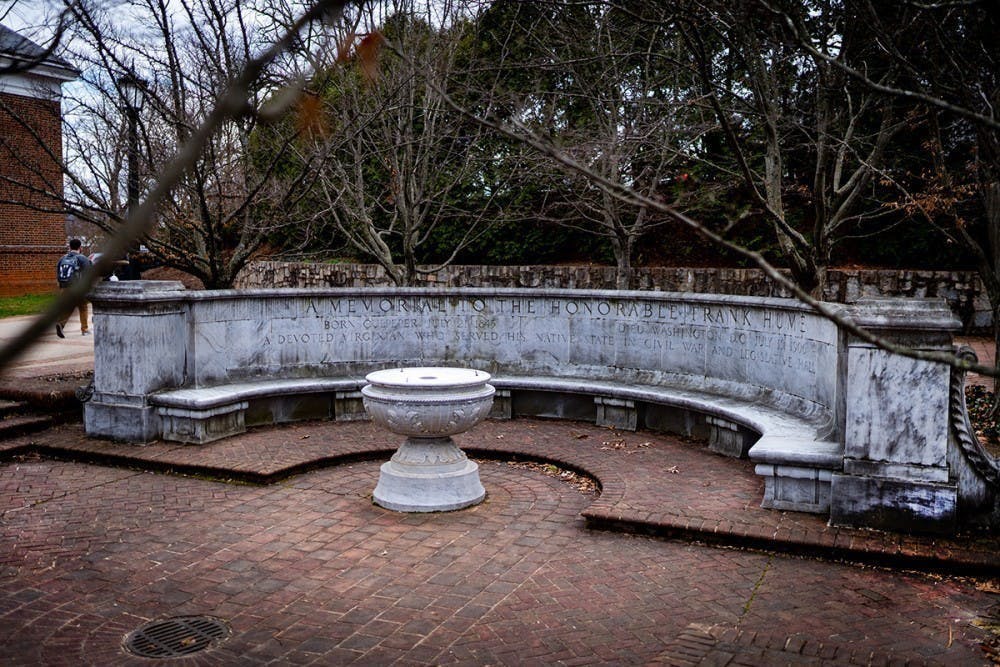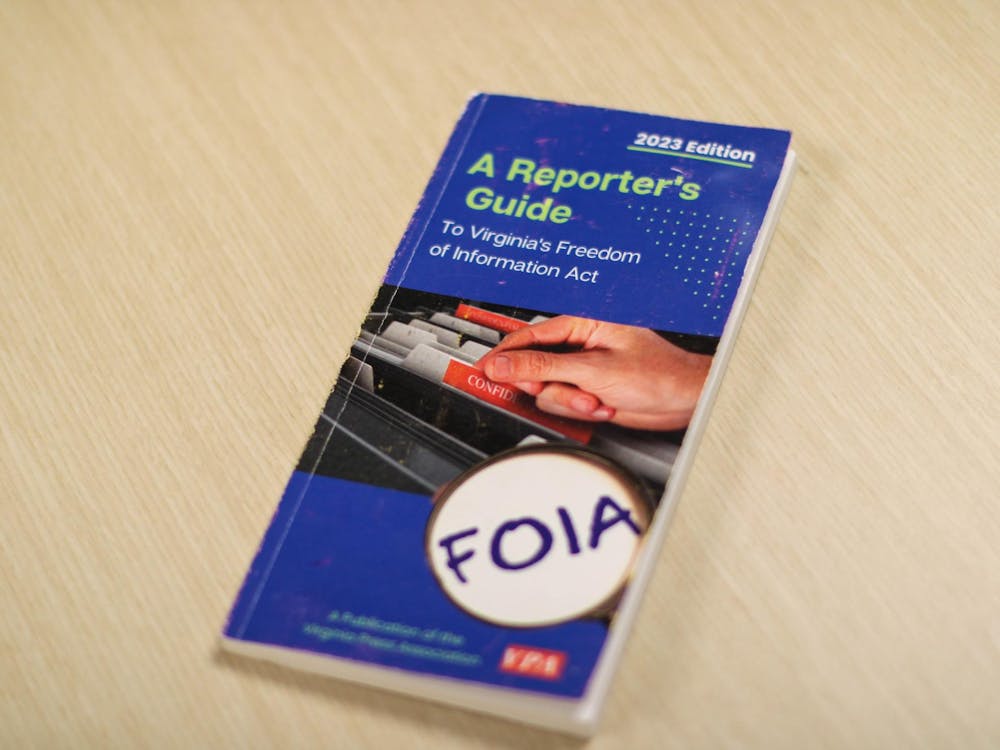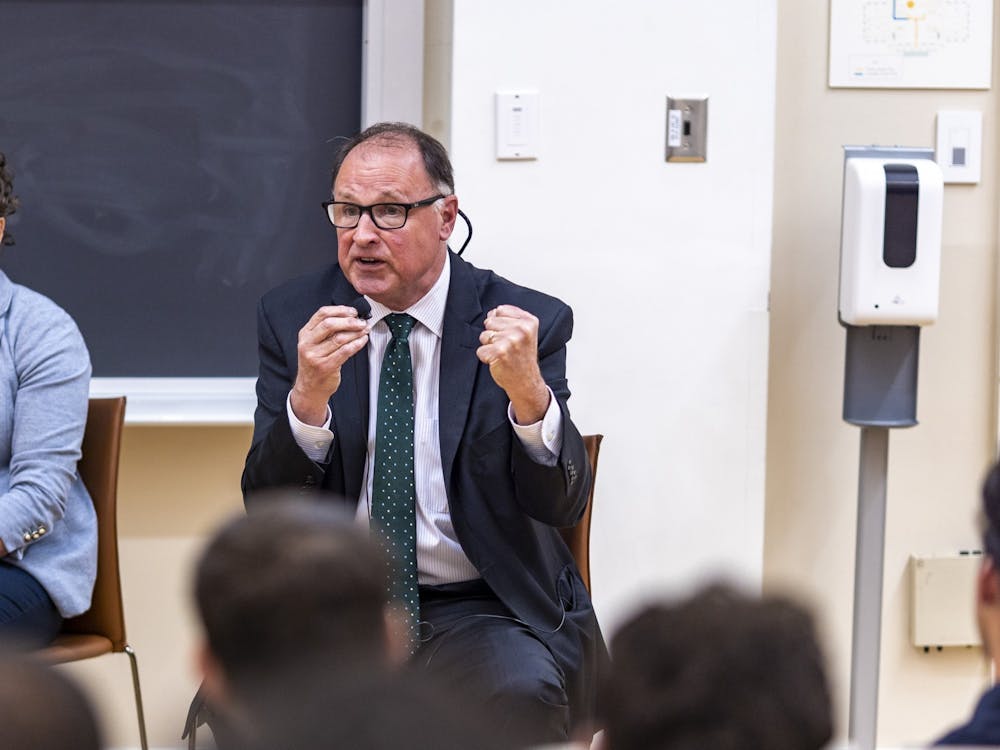The Minority Rights Coalition launched a petition and letter campaign Feb. 7 calling for the Naming and Memorials Committee to remove the Frank Hume Memorial Fountain — otherwise known as the Whispering Wall — due to Hume’s Confederate background.
The MRC is an alliance of seven student organizations focused on supporting marginalized groups — the Asian Student Union, the Black Student Alliance, the Latinx Student Alliance, the Middle Eastern Leadership Council, the Muslim Students Association, the Native American Student Union and the Queer Student Union.
“The structure will always serve as a reminder that the racist ideals upheld by the Confederacy are also ideals the University is proud to preserve,” the MRC said in an open letter to the University.
Hume, who was born in Culpeper County in 1843, fought for the Confederate Army during the Civil War and also served in the Virginia House of Delegates. His two sons, John and Howard Hume, both attended the University — Hume himself was a resident of Alexandria and was considered a benefactor of the University.
The Frank Hume Memorial Fountain was erected near Monroe Hall and Newcomb Hall in 1938, and John and Howard Hume were major donors for its construction. It consists of a marble fountain and a wall that can carry whispers from one end to the other, hence its nickname — the Whispering Wall. The inscription on the wall describes Hume as “a devoted Virginian who served his native state in civil war and legislative hall.”
Abena Appiah-Ofori, MRC vice chair of advocacy and second-year College student, is spearheading the MRC’s push — which went public Feb. 7. — to remove the Frank Hume Memorial. The MRC’s open letter to the University contains a call to include Black students in discussions surrounding the memorial. The Black Student Alliance, among other minority student groups such as the Asian Student Leadership Council and the Latinx Student Alliance, have signed the letter in solidarity.
“If administration and University officials want to continue to work in favor of African Americans … and people who want to feel fair or feel more at home at the University, then they will take it into consideration of removing [the memorial] so to make it more of a welcoming community,” said Deric Childress Jr., third-year College student and president of BSA.
The campaign is in response to the Board of Visitors’s endorsement of several proposals from the Racial Equity Task Force’s report, which addresses promoting racial equity at the University. Last September, the Board voted to remove or rededicate the memorial, and the newly created Naming and Memorials Committee will ultimately decide the fate of the wall. The eight-member committee, which includes two African American Studies professors, will make recommendations on building names and memorials on Grounds.
Michael Suarez, English professor and director of the Rare Book School, chairs the Naming and Memorials Committee. Due to the recent establishment of the committee, Suarez could not provide an exact date for discussions about the memorial.
The committee’s first order of business is to develop a recommended course of action regarding the contextualization of statues and memorials at the University, he said. Following that, they will take on the issue of the Frank Hume Memorial, beginning with examining the history of the wall.
“We will need to spend time and effort to weigh the available possibilities with care as we are committed to serious reflection and scholarship,” Suarez said in an email to The Cavalier Daily.
Prior to the Feb. 8 announcement of the Naming and Memorials Committee, Appiah-Ofori reached out to multiple leaders in equity initiatives at the University about the progress of finalizing the memorial’s status, including Kevin McDonald, vice president for diversity, equity, inclusion and community partnerships, and Barbara Brown Wilson, faculty director of the Equity Center. Both were unaware of any upcoming plans regarding the Frank Hume Memorial. McDonald serves as a consultant for the Naming and Memorials Committee.
Appiah-Ofori characterized one response from Wilson as “dismissive” in its implication of wanting to move on without addressing the memorial issue. Appiah-Ofori had individually appealed to Wilson, asking her to “choose to unequivocally remove the Whispering Wall in its entirety.”
“Thanks so much! It is always wonderful to see students using their collective power to advocate for justice,” Wilson said in her email response to Appiah-Ofori. “What is next on your list of priorities?”
The Naming and Memorials Committee is aware of the MRC campaign and will factor their input into consideration of their final recommendation to the University.
Wilson said that because she is not a decision-maker on the Hume memorial, her intention with her responses to student emails was to be supportive of efforts.
“It was in no way meant to be dismissive,” Wilson said.
Wilson also said that there is a meeting scheduled with student leaders and individuals at the Equity Center to discuss how to best support them.
“I can pledge that the Committee is committed to attend to the thoughtful comments of all,” Suarez said.
Appiah-Ofori first learned of the wall’s Confederate connection last spring when a fellow Black student told her about how she had cried after searching Hume’s name online. Having only known the monument as the Whispering Wall from orientation, Appiah-Ofori was shocked.
“I always have to walk by the Whispering Wall to get to my English class that I had,” Appiah-Ofori said. “It made me feel really [bad] as a Black student, having to walk by a Confederate memorial every single day.”
Childress only learned about the memorial’s history recently when MRC began its campaign. He believes many other students are similarly unaware of the traces of Confederate history on Grounds.
“The biggest thing with knowing things about U.Va. and the history of racism and inequality here is educating, and a lot of people aren’t educated on the memorials or the statues the University of Virginia has posted up within this community,” Childress said.
The George Rogers Clark statue, which will be removed from the Corner after a Board of Visitors vote in September, shows Clark on horseback, looming over three Native Americans. Clark was a Revolutionary war general who led campaigns against Native Americans.
The Thomas Jefferson statue on the north side of the Rotunda will be contextualized to address his status as a slave owner and his exploitation of enslaved labor to build the University. A petition that circulated last summer details the problematic backgrounds of many building namesakes — 23 in total — and most whom are related to slave ownership and white supremacy.
The MRC’s petition and letter campaign is a continuation of Appiah-Ofori’s efforts from last year. Last June, looking to contribute tangibly to the Black Lives Matter movement, Appiah-Ofori and a friend — second year College student Chloe Leon — began their own petition to remove the Whispering Wall. The petition currently has over 2,120 signatures and succeeded in securing the attention of University officials. President Jim Ryan acknowledged the support for the petition and sent it to the Racial Equity Task Force during the creation of the report, according to an internal email obtained by The Cavalier Daily.
The task force’s decision to also consider rededicating the memorial, however, disappointed Appiah-Ofori. Rededicating the memorial would keep the wall intact on Grounds, but would remove Hume’s namesake.
“I don’t think they were listening to us,” Appiah-Ofori said. “Honestly, I think they want to go with the cheaper option, because obviously it’ll cost a lot more money to move it in its entirety rather than just pasting a different name on there.”
The MRC is promoting their campaign on social media and plans to gather support by visiting the general body meetings of other student organizations such as BSA.
“This is only the beginning, and we should keep fighting for more equity and more fairness and more sense of home for people coming to the University,” Childress said.







